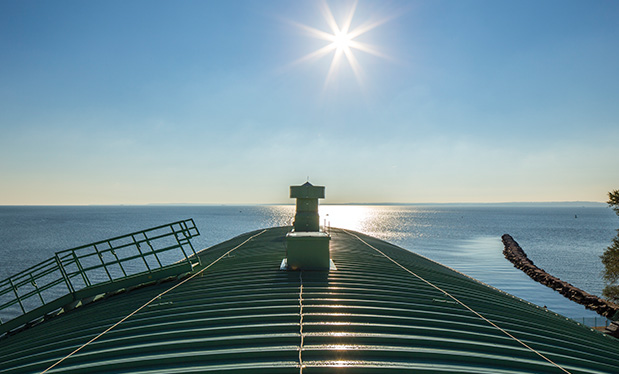This month, NRCA published The NRCA Roofing Manual: Metal Panel and SPF Roof Systems—2016. The manual provides new and updated best practice guidelines applicable to metal panel and spray polyurethane foam (SPF) roof systems and replaces The NRCA Roofing Manual: Metal Panel and SPF Roof Systems—2012.
The NRCA Roofing Manual currently consists of The NRCA Roofing Manual: Steep-slope Roof Systems—2013; The NRCA Roofing Manual: Architectural Metal Flashing, Condensation and Air Leakage Control, and Reroofing—2014; The NRCA Roofing Manual: Membrane Roof Systems—2015; and The NRCA Roofing Manual: Metal Panel and SPF Roof Systems—2016.
Following is an overview of the changes and new information contained in the SPF roof systems section of The NRCA Roofing Manual: Metal Panel and SPF Roof Systems—2016. An article focusing on the metal panel roof systems section will appear in the October issue of Professional Roofing.
Manual development
Similar to NRCA's other technical publications, the 2016 manual was developed by roofing professionals who serve on NRCA committees. However, this section of the manual required the assistance of roofing professionals who possess knowledge specific to SPF, so an SPF Task Force was formed and given the responsibility of reviewing the 2012 edition and developing the 2016 edition. The task force included Jack Moore Jr., president and CEO of West Roofing Systems Inc., La Grange, Ohio, and Jim Andersen, president of JA Consulting LLC, Amery, Wis., (formally with BASF Corp.), who provided valuable input and guidance. Once the final draft was completed, it was reviewed and approved by NRCA's Manual Update, Technical Operations and Executive committees.
Content organization
The NRCA Roofing Manual: Metal Panel and SPF Roof Systems—2016 was reorganized to match previous NRCA roofing manuals, so the chapter containing the roof system configurations appears first. The SPF roof systems section is divided into eight chapters:
- Chapter 1—Roof System Configurations
- Chapter 2—Roof Decks
- Chapter 3—Other Substrates
- Chapter 4—Spray Polyurethane Foam
- Chapter 5—Protective Surfacings
- Chapter 6—Roof Accessories
- Chapter 7—Reroofing
- Chapter 8—Construction Details
Following is an explanation of each chapter and noteworthy changes.
Chapter 1—Roof System Configurations provides technical information concerning the design and installation of quality SPF roof assemblies. This chapter is intended to be used as a guide for designers when specifying SPF roof systems and developing their own drawings and specifications for specific projects. There are roof system configurations applicable for new construction and roof re-cover and roof system replacement projects.
New roof system configurations were added and include SPF roof systems with protective membrane surfacings and an SPF application directly to a steel deck.
For example, the system configuration description for an SPF roof system installed over a nailable deck includes information about roof slope limitations, nailable deck types, air and vapor retarders, SPF, protective surfacing, flashings and roof accessories. The individual components' descriptions provide specific references to the chapters where more detailed information about these components can be found. Also, descriptive roof system illustrations are provided.
Chapter 2—Roof Decks discusses roof deck types commonly used with SPF roof systems and includes cementitious wood-fiber, lightweight insulating concrete, steel, structural concrete and wood substrates. SPF-specific considerations are included for each roof deck type. For example, NRCA does not recommend direct application of SPF over a lightweight-insulating concrete roof deck because of the residual moisture content of a wet-fill deck. SPF may become dimensionally unstable when moisture vapor from the lightweight insulating concrete is absorbed by SPF.
This chapter added a new application option for steel decks. Experience has shown SPF can be directly applied to a steel deck. In this application, an asphalt-coated woven fabric is rolled out over a primed, steel deck. SPF is sprayed over the fabric to bond the fabric to the steel deck without the use of fasteners.
The structural concrete section also was updated to reflect NRCA's concerns about lightweight structural concrete as explained in NRCA's August 2013 Industry Issue Update, "Moisture in Lightweight Structural Concrete Roof Decks."
A new caution was introduced to the wood panel deck section. Many SPF components may not be compatible with wood panel roof decks treated with oil-borne preservatives. The task force reported most SPF manufacturers recommend wood decks be constructed with wood that has been treated with non-oil-preservative pressure treatment or with nontreated air- or kiln-dried lumber.
Because SPF can be directly applied to substrates other than a roof deck, Chapter 3—Other Substrates addresses appropriate substrates for an SPF application, such as base sheets and rigid board insulation.
This chapter references the various types of rigid insulation board commonly used in SPF roof systems. The previous edition listed and described cellular glass, faced-gypsum board, fiber-reinforced gypsum board, mineral fiber, perlite, polyisocyanurate, wood fiberboard, composite board and tapered insulation. For the 2016 manual, the task force removed cellular glass, mineral fiber (stone wool) and polystyrene because these insulation types aren't considered suitable substrates for an SPF application. For this reason, the task force removed them from the chapter.
A new recommendation was introduced for some rigid board insulation installations. Experience has shown tight butt joints with certain insulation types lead to possible cracking in SPF and the protective coating. NRCA now recommends leaving small gaps between board edges when applying SPF over glass-faced gypsum board, fiber-reinforced gypsum board, polyisocyanurate and high-density polyisocyanurate and wood fiberboard.
SPF material and its application are addressed in Chapter 4—Spray Polyurethane Foam. This chapter addresses job-site considerations, weather conditions, equipment and primers. Also included is information about application considerations, such as thickness and surface texture. Generally speaking, there were not many significant changes to this chapter's content.
Protective surfacings
Chapter 5—Protective Surfacings discusses protective surfacings used with SPF roof systems. Protective surfacings provide weatherproofing, ultraviolet (UV) protection, mechanical damage protection and fire resistance. This chapter addresses design considerations for protective surfacings, such as applicable performance properties. Weatherability wasn't addressed in the list of performance properties in the 2012 manual, so it was added at the task force's request.
Weatherability is the property of a material that allows it to endure or resist exposure to the weather. The use of long-term in-field testing to validate a coating or protective membrane's performance typically is a requirement for testing using ASTM International standards for coatings or membranes. These tests typically involve measurements of deterioration or observations made for specific timelines used for predicting performance. UV exposure, thermal cycling and water are important elements when testing coatings or membranes.
Generally, there are two types of protective surfacing—coatings and roof membranes. For the previous edition, the committee decided the foam in SPF roof systems that incorporated membrane surfacing technically was low-rise foam, so design information regarding protective membranes was eliminated. However, the most recent task force had a different opinion, and as a result, roof membranes now are addressed as a protective surfacing. Membrane surfacing for SPF roof systems typically consist of EPDM or TPO membranes with a laminated nonwoven polyester fleece, commonly referred to as fleece-backed roof membranes. As previously mentioned, new roof system configurations were added to Chapter 1—Roof System Configurations.
Chapter 6—Roof Accessories reviews pre-manufactured roof accessories that may be provided or installed by other trades that are integrated into a roof system. These accessories can be critical to the weathertight integrity of a completed roof system. This chapter was further expanded by adding new content regarding pipe support systems, lightning protection and rooftop walkway systems.
As previously mentioned, the manual's SPF section was updated to reflect the format adopted from previous NRCA manuals. Relevant reroofing information from The NRCA Roofing Manual: Architectural Metal Flashing, Condensation and Air Leakage Control, and Reroofing was added to Chapter 7, and the title changed from "Roof Re-covering" to "Reroofing."
Chapter 7—Reroofing is broken down into the following topics: definitions; evaluation of existing roof systems; building code requirements; roof decks for reroofing; preparation of existing roof surfaces; re-cover guidelines for SPF roof systems; and design guidelines for roof system replacement with new SPF roof systems.
Construction details
Chapter 8—Construction Details has an introduction for use with the construction details as a supplement to the special notes on the individual construction details. The introduction includes topics such as preservative-treated wood; job-site-fabricated components; penetrations and clearance recommendations; metal flashing components; parapet walls; expansion joints; saddles and crickets; drains; and surface protection.
With the return of roof membranes as a protective surfacing, a new set of construction details addressing this roof system type was added. The new set of drawings for SPF roof systems with fleece-backed membrane surfacings are identified as SPF(FB)- construction details. Although membrane surfacings typically consist of EPDM (thermoset) or TPO (thermoplastic) membranes, the construction details attempt to address both membrane types, but roof system designers should consult with the membrane manufacturers for their specific projects.
New construction details were added to match flashing situations introduced in The NRCA Roofing Manual: Membrane Roof Systems—2015. Details for pipe supports and a sheet-metal hood now are included. Also added is a new SPF re-cover detail that addresses situations where new perimeter edge metal is installed over existing perimeter edge metal that is to remain in place.
Chapter 8 contains 28 construction details addressing SPF roof systems with protective coatings, 28 construction details addressing SPF roof systems with fleece-backed roof membranes and 16 construction details for roof re-covering situations. As with previous manuals, a letter designation for certain details is included. This identifies NRCA's order of preference for addressing a specific detail condition.
The SPF construction details provided in the manual are based on best industry practices and have been time-tested. Some may argue the SPF construction details are not as conservative as the membrane roof system details. The details have been brought to a level of conservatism that matches details that have performed well in the field for a number of years.
As an example, Figure 1 is SPF-(R)12A, "Roof Drain for SPF Re-cover," that illustrates a drain strainer placed directly on top of a protective coating set in sealant; a clamping ring was not included. This detail was removed from the 2012 manual because the Manual Update Committee, at that time, preferred clamping rings be used. But based on the experiences of the current SPF Task Force members, NRCA recognizes certain SPF details, such as this roof drain detail, can perform successfully during a roof system's expected service life. Therefore, the detail was included in the 2016 manual; however, note the preferred detail is the roof drain that includes a clamping ring.
Now available
The SPF portion of The NRCA Roofing Manual: Metal Panel and SPF Roof Systems—2016 is an up-to-date, authoritative technical reference concerning the design, materials and installation of quality SPF roof systems. The manual provides nonproprietary SPF construction details you likely will not find through another source in the roofing industry that offers SPF construction details based on feedback from knowledgeable, practicing roofing professionals.
Joan P. Crowe, AIA, is an NRCA director of technical services.
Individual employees of NRCA member companies can access free electronic copies of The NRCA Roofing Manual: Metal Panel and SPF Roof Systems—2016 via NRCA's app or online. Individuals will need their companies' NRCA member ID numbers to access the manual.
To download the NRCA app, visit the Apple App Store, Google Play or Windows Store.
To download a PDF copy of the manual, visit NRCA's online store, shop.nrca.net.
Hard copies of the manual also are available for purchase at shop.nrca.net.
Nonmembers may purchase electronic or hard copies of the manual online at shop.nrca.net.



